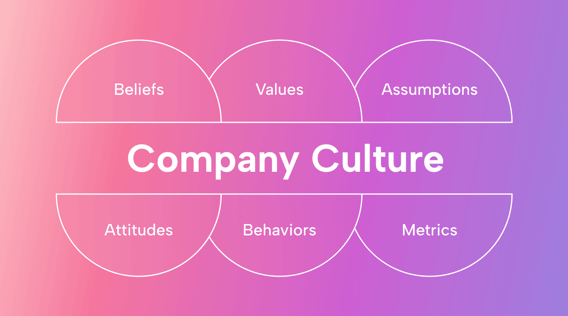Ever wondered why some companies are employee magnets while others can’t seem to hold onto their people?
The secret often lies in the company culture.
But what does an exceptional company culture look like?
In this article, we pull back the curtain on some of the most awe-inspiring company culture examples from around the nation. You’ll see firsthand how these companies have created environments where employees don’t just work — they thrive.
Whether you’re looking to revamp your own corporate culture or just curious about what makes these workplaces tick, we’ve got the details.
What is company culture?
Company culture, also known as organizational or workplace culture, is the unique blend of values, beliefs, and practices that define a business. Culture impacts everything from how daily tasks are handled to how team members interact and make business decisions. It’s a vital part of any organization.
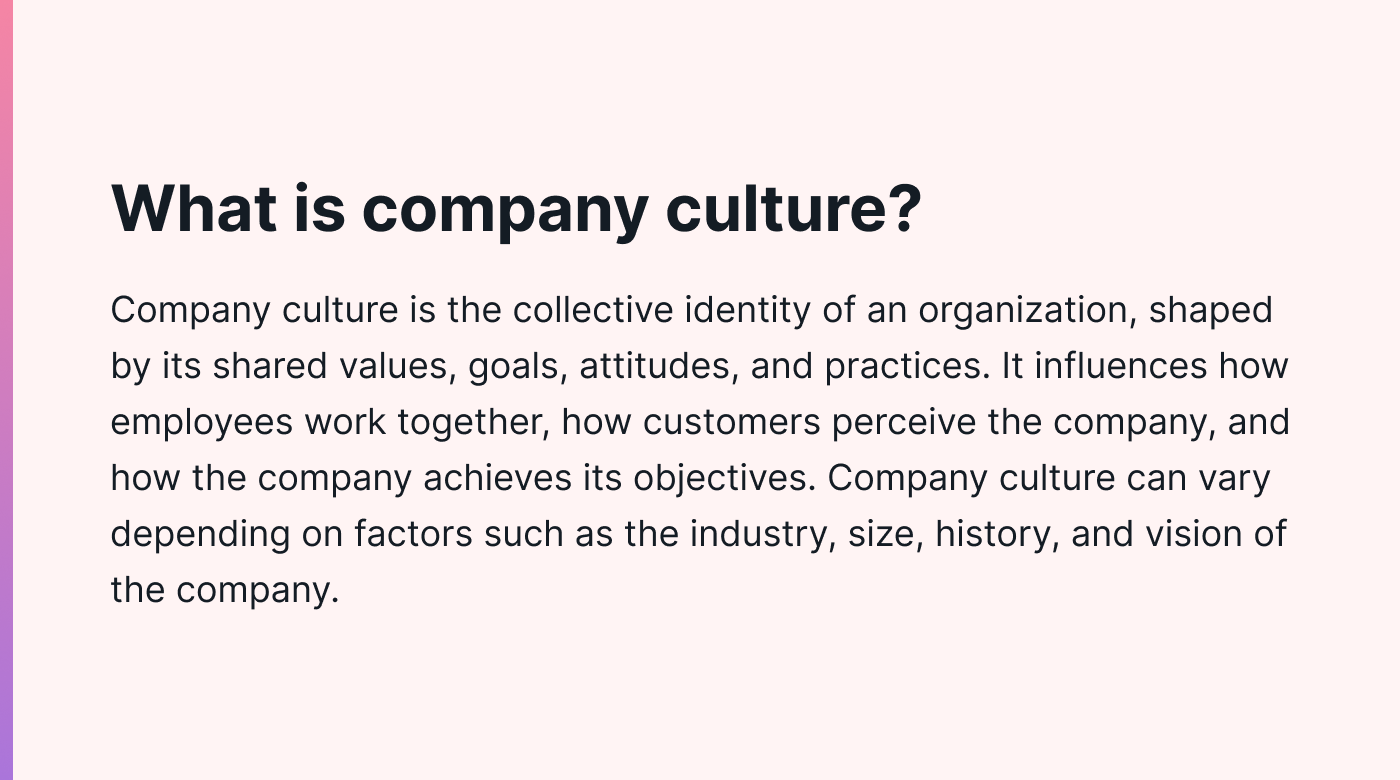 |
So, why is it so important?
Seventy-six percent of employees say that a strong culture is key to excelling in their roles. Even more telling, 51% consider waving goodbye if they don’t feel a sense of belonging.
With this information in mind, let’s take a look at what makes a company culture great.
What does a strong company culture look like?
Many think that a strong company culture is all about cool perks or a hip office space, but that’s not the case at all. The real magic happens beneath the surface.
You’ll know your company culture truly resonates with your team when:
- Your employees are engaged and invested in their roles: Employees who feel connected to their company culture are 3.7 times as likely to be engaged at work.
- Turnover rates drop: Employees who work in organizations that put people first are 3.2 times more likely to stick around than those who don’t.
- You attract top talent.
- Your team collaborates more efficiently.
- Customer and employee satisfaction soars.
- The business’s financial performance gets a boost.
- A healthier work-life balance becomes the norm, not the exception.
- You notice a surge in innovation and growth.
These positive changes are a clear sign that you’ve crafted more than just a workplace — you’ve nurtured a thriving community.
8 organizational culture examples
Ready for some inspiration? Check out the eight company culture examples below. They’re packed with actionable ideas to energize your team and enhance productivity.
Let’s explore what makes each of them work.
 |
1. Clan culture
At the heart of clan culture lies a simple yet powerful idea — that your colleagues feel like family.
Clan culture thrives on teamwork, collaboration, and a deep sense of loyalty. It’s all about empowering each other and building a close-knit community within the office walls.
The upside? You’ll find a workplace brimming with trust, open communication, and a genuine commitment to shared goals.
But it’s not always smooth sailing. With such a strong focus on harmony and consensus, clan culture can sometimes trip over conflicts, struggle with groupthink, or find it tough to adapt to change. After all, when everyone agrees, who’s challenging the status quo?
Recreational Equipment, Inc. (REI), a member-owned co-op that sells outdoor gear, is a great example of clan culture in action. They truly put their people first, and it shows.
Since 2015, for instance, they’ve been closing their doors on Black Friday to give their employees a break. This is a bold move that shows the strengths and challenges of a clan culture — nurturing a supportive, family-like atmosphere while navigating the occasional rough waters.
2. Market-driven culture
A market-driven culture is all about getting top results, with a sharp focus on beating the competition and meeting customer needs. In this fast-paced setting, the goals are crystal clear: ramp up productivity, increase profits, and keep customers satisfied.
While this high-octane approach has its perks, such as boosted efficiency and happy customers, it’s not without its challenges. The non-stop drive for success can sometimes be overwhelming, leading to employee stress or burnout. And in the race to the top, ethical considerations can sometimes be hazy.
Amazon is a textbook example of this type of culture. Their Leadership Principles, which include customer obsession, setting high standards, quick decision-making, and focusing on results, perfectly illustrate a market-driven approach. These company values push Amazon to constantly innovate and keep its customers front and center.
However, this intense focus on achieving and delivering can also lead to a pressure cooker situation for their teams. It shows how a market-driven culture can skyrocket a business to success and highlights the importance of balancing ambitious business goals with a supportive work environment.
3. Adhocracy culture
Adhocracy culture is like the wild, creative cousin of the corporate family. Here, companies thrive on trying new things, thinking outside the box, and taking risks. It’s an energetic, idea-driven environment where innovation isn’t just welcomed — it’s the norm.
This kind of culture comes with some exciting benefits. It makes companies nimble, adaptable, and open to growth in innovative ways.
However, it’s not without its hurdles. The thrill of innovation comes with its share of chaos and uncertainty. And with bold risks, there’s always a chance things might not work out.
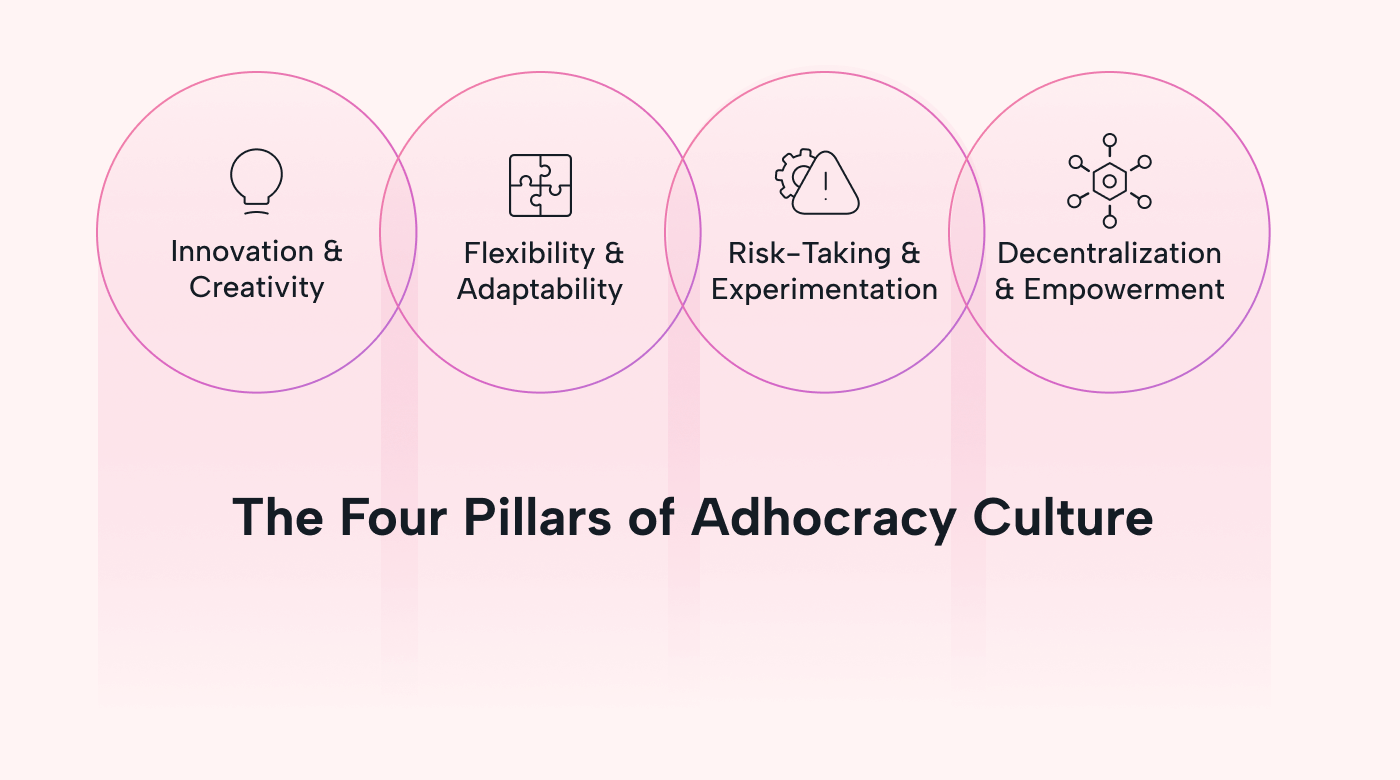 |
Netflix is a perfect example of adhocracy culture. They’ve redefined the entertainment game, first with their DVD-by-mail service and then by pioneering streaming. Their core values, which include “freedom and responsibility” and “context, not control,” reflect their aversion to rigid rules.
This mindset has propelled Netflix to become a leader in innovation. However, it also means the company must navigate the tricky waters of balancing constant innovation with the inherent risks and uncertainties that come with it.
4. Hierarchy culture
Think of hierarchy culture as the corporate world’s version of a well-oiled machine. It’s a culture that puts a premium on structure, order, stability, and control.
In a hierarchy culture, authority is clear-cut, roles are well-defined, and established processes are strongly emphasized.
A hierarchical culture excels in delivering consistency and reliability, with a well-ordered system where everyone is clear on their role and timing. However, it’s not perfect. The emphasis on structure can lead to bureaucracy and rigidity, making it difficult to adapt to change. And sometimes, a too-comfortable environment can breed complacency.
A classic example is the Ford Motor Company. From its roots as a family business to a global automotive leader, Ford has always leaned into a structured approach.
However, Ford is not just sticking to its old ways.
Recognizing the pitfalls of a too-rigid culture, Ford has been working to shake off any toxicity and bring a fresh, more modern approach to its hierarchy. They’re proving that even established giants can learn to bend and flex with the times.
5. Results-oriented culture
In a results-oriented culture, it’s all about hitting those targets and celebrating achievements. Companies with this mindset are firmly focused on outcomes, performance, and getting the job done.
There’s a real buzz in these workplaces, with everyone geared toward not just meeting their goals but smashing them.
This culture brings some big wins, including a boost in productivity and profitability — not to mention customers who love the results. But it has a few drawbacks, too. The constant drive for business success can sometimes lead to stress and burnout among the team. And in the rush to get results, ethical lines might get a bit blurry.
Take Best Buy as an example. They’re known for their relentless pursuit of sales and performance targets, a strategy that’s made them a retail leader. But this also puts the spotlight on the need to balance their results-driven ethos with caring for their team and maintaining strong ethical standards.
6. Purpose-driven culture
A purpose-driven culture is centered around making a positive impact and aligning work with deeper values. Companies with this mindset go beyond just making money. They’re passionate about leaving a positive impact and doing meaningful work.
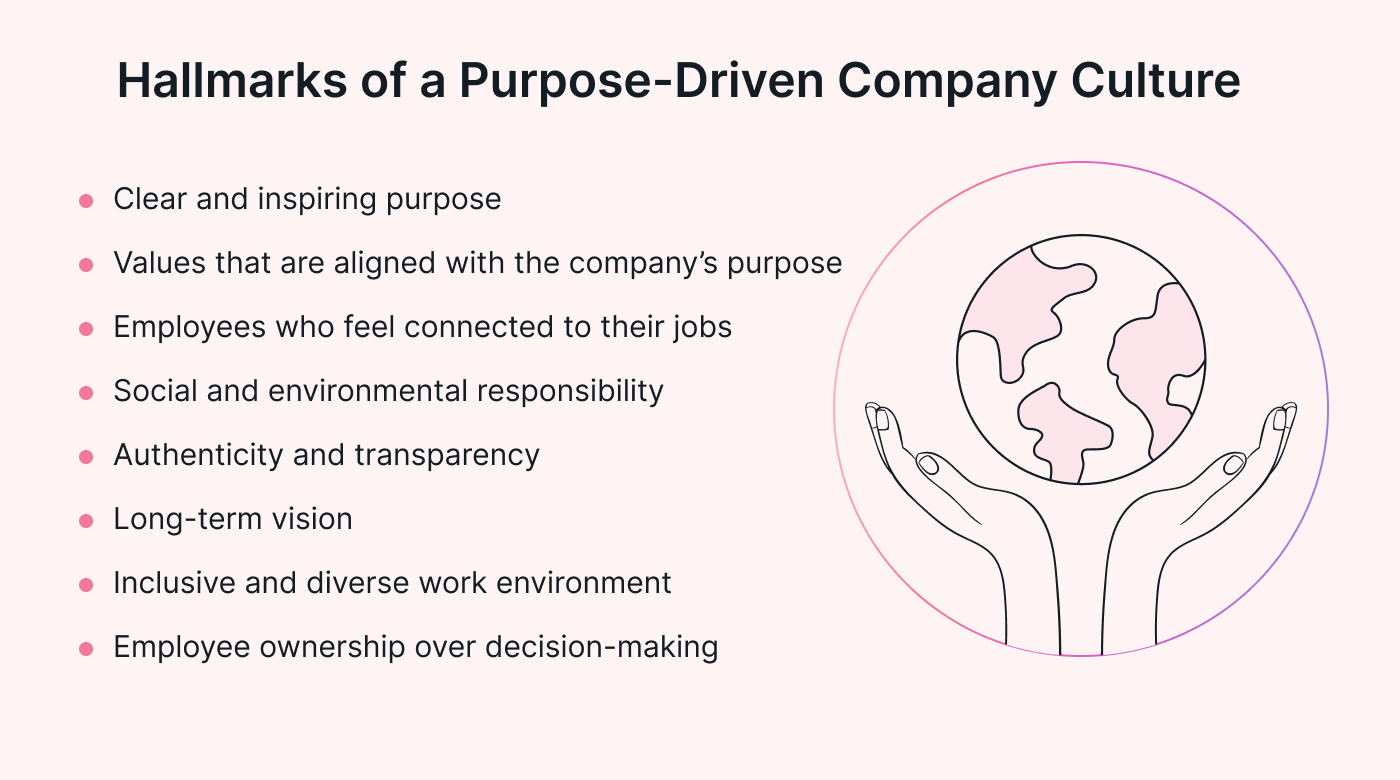 |
This vibe really excites employees because they feel like they’re part of something special, and it even drives some pretty cool innovations. But it’s not always easy. Juggling social goals and profits can be tricky, and aligning multiple values can lead to conflicts.
TOMS shoes is the poster child for a purpose-driven culture. This company began by giving away a pair of shoes for each pair sold. Then, in 2019, they switched gears to donate a third of their profits to various causes, showing they’re serious about staying impactful.
The TOMS brand is also picky about who they team up with, sticking with partners who match their mission. This keeps them on track to meeting their big-picture goals.
7. Strong leadership culture
In a strong leadership culture, leaders are more than just bosses — they’re visionaries who shape the entire company’s path and inspire their employees. In these places, the big bosses do more than just call the shots — they embody the company’s values and set a clear direction for success.
The benefits of this type of company culture? It ramps up employee engagement and performance across the board. People know where they’re heading and are eager to contribute, which often leads to some pretty innovative ideas.
But it’s not always a walk in the park. The pressure to meet high expectations can be intense, and clashes can happen if a leader’s style doesn’t quite mesh with their team.
General Electric (GE) is a prime example of a company with a strong leadership culture. They’re famous for their strong leadership approach, with leaders who do more than manage — they inspire and drive the company forward. This leadership style has put GE on the map, but it also means their leaders and teams must balance dreaming big with everyday teamwork.
8. Innovative culture
Think of an innovative culture as the company’s own think tank, where new ideas are the stars of the show. In these workplaces, there’s always an appetite for the next big thing, and the usual way of completing tasks is constantly questioned.
The upside to this type of culture is that it keeps the vibe fresh and helps the company shift gears as necessary to stay ahead. However, innovation isn’t risk-free. Not every new idea hits the mark, and deciding where to focus resources can be a head-scratcher. Plus, keeping pace with rapid innovation is a constant challenge.
Tesla is a perfect example of a company with an innovative culture. They’re more than just a car company — they’re constantly pushing the envelope in transportation and energy. Their commitment to pushing boundaries keeps them leading the pack, but it also means they have to be smart about which risks to take and how to keep up with the latest tech wave.
How to assess your current company culture
Getting a real read on your corporate culture can be a bit like detective work.
Start with employee surveys to determine the general vibe. Then, dive deeper with one-on-one interviews. Don’t forget to just observe — how people interact on a daily basis can tell you a lot. And a good old-fashioned audit of your policies can uncover what’s written versus what’s actually practiced.
Once you’ve gathered all these pieces, it’s time to make sense of them. What stands out? Maybe there’s a lot of positivity in one area but some concerns in another. Tools like the Organizational Culture Assessment Instrument (OCAI) or the Denison Organizational Culture Survey (DOCS) can help sort through this info and give you a clearer picture.
And here’s a pro tip: No matter the culture you’re nurturing, keep things streamlined and communication clear.
This is where a tool like Motion comes in handy. Motion is a smart assistant that sorts out tasks and schedules for your team, adjusting on the fly when things change. This means less time spent juggling calendars and more on the important stuff. Plus, Motion cuts down on the need for micromanaging — giving your team the space to breathe and do their best work.
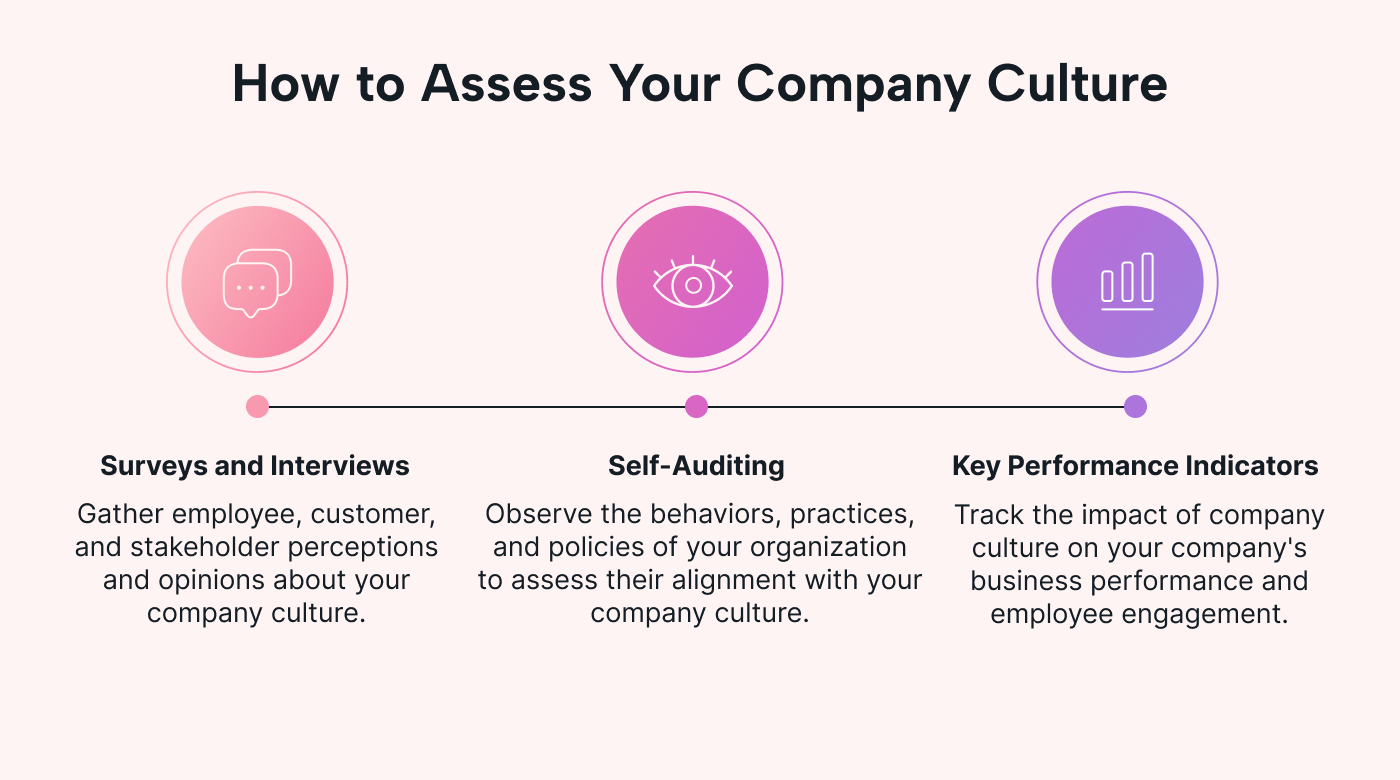 |
Elevate your culture with Motion
From the awe-inspiring company culture examples we’ve explored, it’s crystal clear that a positive company culture is much more than fancy perks or a cool office. It’s about creating an inclusive environment where employees feel valued, connected, and empowered to excel. These leading companies have shown that focusing on culture pays off with happier staff, lower turnover, and a thriving business.
If you’re inspired to enhance your company culture, efficient management and seamless communication are key. That’s where Motion comes in. It prioritizes tasks smartly, reducing the need for constant check-ins and minimizing micromanagement. Motion gives your team the freedom to be happier and more productive.
Ready for a culture shift? Sign up for Motion’s 7-day free trial today.

